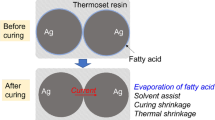In this work, the effects of the degree of cure on the electrical and mechanical behavior of an anisotropic conductive film (ACF) were investigated. The degree of cure of the ACF as a function of bonding time was quantified by dynamic differential scanning calorimetry (DSC) study and attenuated total reflectance/Fourier-transform infrared (ATR/FT-IR) analysis. According to the results, the thickness expansion rate of the ACF as a function of temperature decreased and the storage modulus increased as the degree of cure increased. In addition, the contraction stress of a partially cured ACF with a degree of cure below 40% was much smaller than that of an ACF with a degree of cure above 90%. The ACF contact resistance decreased and the ACF peel adhesion strength increased as the degree of cure of the ACF increased. In particular, poor electrical contact was observed when the degree of cure was below 40%. The ultimate tensile strength (UTS) increased as the degree of cure increased and was closely related to the peel adhesion strength. Furthermore, ACF joints with a degree of cure below 40% had higher contact resistance than those with a degree of cure above 90% during 85°C/85% relative humidity testing.
Similar content being viewed by others
References
J. Liu, Conductive Adhesive for Electronics Packaging (Electrochemical: Port Erin, 1999), p. 12.
S. Ganesan and M. Pecht, Lead-free Electronics (New Jersey: Wiley, 2006), p. 437.
W.S. Kwon and K.W. Paik, IEEE Trans. Compon. Packag. Technol. 29, 528 (2006).
K.W. Jang, C.K. Chung, W.S. Lee, and K.W. Paik, Microelectron. Reliab. 48, 1052 (2008).
W.S. Kwon and K.W. Paik, Int. J. Adhes. Adhes. 24, 135 (2004).
M.A. Uddin, M.O. Alam, Y.C. Chan, and H.P. Chan, Microelectron. Reliab. 44, 505 (2004).
W.S. Kwon, S.Y. Yang, S.B. Lee, and K.W. Paik, IEEE Trans. Compon. Packag. Technol. 29, 688 (2006).
C.K. Chung and K.W. Paik, J. Microelectron. Packag. Soc. 15, 7 (2008).
M. Arasa, X. Ramis, J.M. Salla, A. Mantecón, and A. Serra, J. Polym. Sci. A: Polym. Chem. 45, 2129 (2007).
H.J. Kim, C.K. Chung, Y.M. Kwon, M.J. Yim, S.M. Hong, S.Y. Jang, Y.J. Moon, and K.W. Paik, J. Electron. Mater. 36, 56 (2007).
Author information
Authors and Affiliations
Corresponding author
Rights and permissions
About this article
Cite this article
Chung, CK., Paik, KW. Effects of the Degree of Cure on the Electrical and Mechanical Behavior of Anisotropic Conductive Films. J. Electron. Mater. 39, 410–418 (2010). https://doi.org/10.1007/s11664-009-1063-1
Received:
Accepted:
Published:
Issue Date:
DOI: https://doi.org/10.1007/s11664-009-1063-1




